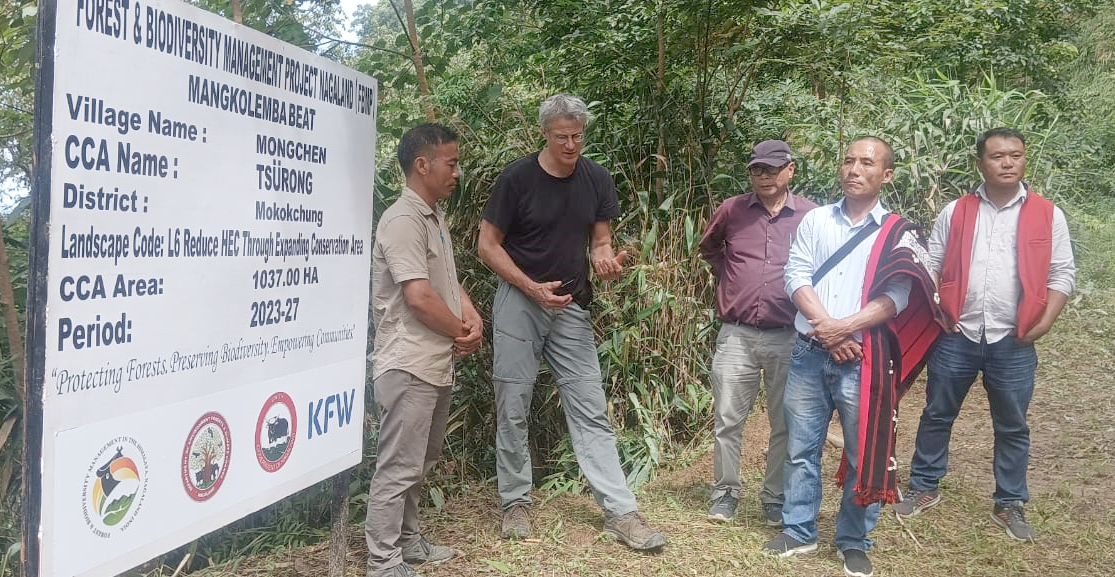The Mid-Term Review (MTR) Mission of the “Forest and Biodiversity Management in the Himalaya, Nagaland” Project (FBMP), co-financed by the Federal Republic of Germany through KfW (German Development Bank), was conducted on September 19 and 20 across selected project villages in Mokokchung.
The project is implemented under Mokokchung Forest Division with Batch-1 villages covering Khar, Mongchen, Dibuia, Alongkima, and Waromung, and Batch-2 villages including Unger, Changtongya Old, Akhoya, and Nukshiyim.
The objectives of the project are to promote sustainable and effective management of forest and biodiversity in Nagaland, support improved connectivity and conservation of biodiversity, enhance livelihood opportunities for dependent communities, and put in place incentive mechanisms rewarding communities for protecting and maintaining their Community Conserved Areas (CCAs), stated Dr Sentitula, IFS, Divisional Forest Officer (DFO), Mokokchung.
The MTR mission was led by Dr Sentitula, DFO Mokokchung, and Moamongba, Assistant Conservator of Forests, along with staff of the Forest Division. The review team comprised Steffen Schuelein, MTR
Consultant; Dr. Chonbenthung Kikon, National M&E Expert, PMC; Paul R, LE; Zulukumzuk Pongen, BME; and Chumbeni Ngullie, Social Media Coordinator.
On the first day, September 19, the team visited Changtongya Old Village (Azunglu CCA) under Batch II, with en route stops at Unger EPA for the beautification of Unger Sungkum village gate through construction of a retaining wall and inscription of the phrase “Unger-Waro Mopongok Yim,” and Akhoya EPA for the construction of a Water Reservoir Tank. At Changtongya, the Community Conserved Area
(CCA), Village Council, and Self Help Groups (SHGs) extended a welcome to the team.
The mission reviewed livelihood activities such as vermi-compost production, which were found to be running successfully with good prospects for sustainability. Discussions with community institutions focused on both successes and challenges, with practical solutions identified together.
Download Nagaland Tribune app on Google Play

On the second day, September 20, the team visited Khar and Mongchen villages (Tsurong CCA) under
Batch I, joined by representatives from the Nagaland Bio-Resource Mission (NBRM). At Khar, the review focused on the ongoing nursery development under the Tsurong CCA Management Plan. At Mongchen, the community showcased their CCA area, the construction of a resting and inspection hut, and patrolling paths. The Mongchen Village Council, SHGs, and CCA representatives welcomed the team and held discussions on challenges such as livestock disease outbreaks in piggery, which is currently the village’s main livelihood activity. Awareness on hunting practices and the need for capacity development for SHGs were also emphasized.

The mission noted significant progress towards project objectives, particularly the integration of livelihood generation with biodiversity conservation. Community members appreciated the project’s participatory approach, which not only provided livelihood assets but also encouraged proposal development and independent idea presentation, strengthening long-term skills, particularly among women SHGs. Villagers also highlighted the value of learning ecosystem functions, afforestation techniques, and practical forest conservation measures. The trust and collaboration developed between the Mokokchung Forest Division as the Project Implementing Agency (PIA) and community members were underlined as a foundation for future progress.
Steffen, MTR Consultant, expressed his gratitude to the Mokokchung Forest Division team and the communities for their warm welcome and hospitality. He commended their commitment and observed that the project had created strong motivation for intensified biodiversity conservation.
For the remaining project years, the mission recommended further strengthening of CCA conservation activities, inter-village cooperation, and awareness and capacity-building initiatives. The MTR team concluded the visit by wishing the participating communities continued success and encouraging them to “keep up the good work.”

